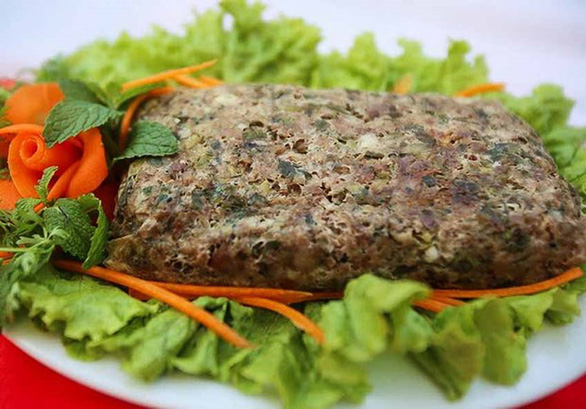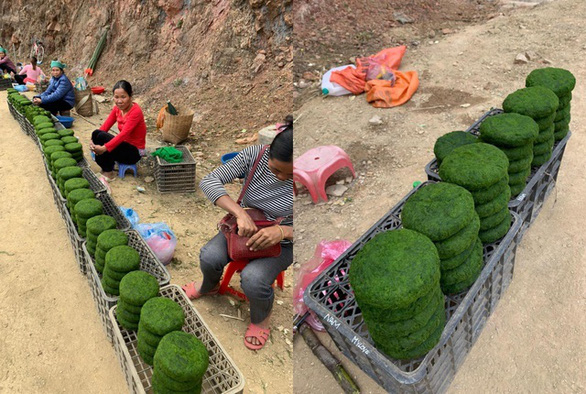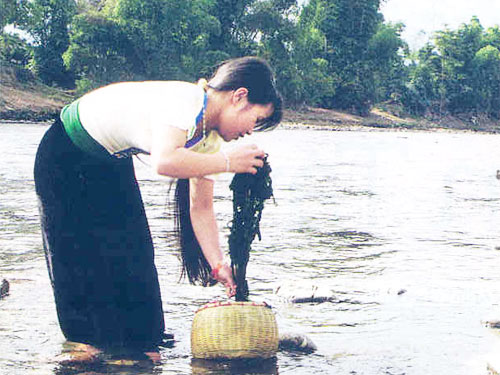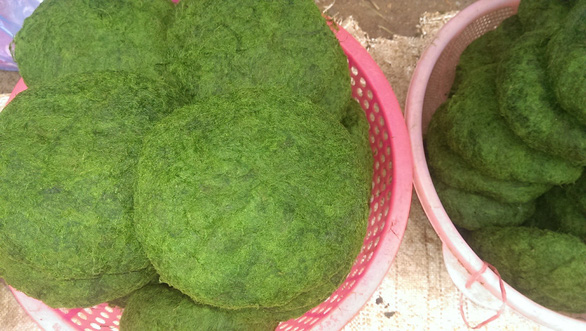People in Vietnam’s northwest region have long considered the moss grown at local streams as an edible delicacy meant for special occasions, such as weddings or festivals.
Common dishes that feature moss in the region include grilled moss, moss soup, stir-fried moss with garlic, and moss salad, all of which are not only appreciated for their flavor, but for their health benefits.
Some of the benefts include improved blood circulation, detoxification, blood pressure stabilization, and immune response enhancement.
|
|
| Moss can also be mixed with ground meat to make meat loaf. |
Moss is also believed to be rich in fiber, which may help reduce blood fat and can be helpful for those who want or need to lose weight.
A tragic love story
Elders in Vietnam’s northwest say that moss is associated with a tragic love of a couple from Thai ethnic group, as well as a tale about Thia -- the largest stream of Muong Lo Valley in the northern province of Yen Bai.
Thia, in the language of local Thai people, means 'tears.' The Thia stream is believed to be made of tears of a Thai woman.
A local man and woman fell in love but their family did not approve of the relationship, according to local legend.
When the woman’s family tried to force her to marry a rich official, the couple decided to run away together.
The official then sent troops to catch the couple. When they found the man and woman, they killed the man and threw him off a cliff. His body then turned to stones.
After losing her one true love, the woman fell into deep grief, and her tears formed the Thia stream.
She eventually drowned herself in the stream and turned into moss clinging to the stones.
Nowadays, in honor of the legend, the Thai people use moss as a main dish in wedding ceremonies to express the desire for youth, love, fidelity, luck, and happiness.
The moss in the Thia stream is considered the most delicious in the northwestern region.
|
|
| This collage of photos shows local people selling processed moss along a road in the northwest region of Vietnam. |
Moss is not planted. Instead, it grows by itself.
All local people have to do is keep the water clean in order for the plant to develop well. Whether the moss grows short or long depends on the stream.
Moss typically begins growing at local streams in the spring and summer. It reaches its maximum length, sometimes as much as two meters, at the end of the year when the weather turns cold.
Locals, however, do not wait until the end of the year.
Rather, they collect the moss in three to four days after it begins to grow and before it turns white and can no longer be consumed.
They also only consume moss thriving in clean and fast-flowing stretches of the stream where the water is knee-deep.
Moss rarely grows in deep, stagnant water, but when it does, it is not clean and often contains a lot of sand and dirt.
Harvesting and processing
Picking heavy hydrated moss from the streams is hard enough, but cleaning it is even harder.
After harvesting moss, locals place it on a wooden board or a flat stone and carefully hit it to remove impurities. The moss is then washed with water. This process repeats a total of three times.
|
|
| A woman picks moss from a stream in the northwest region of Vietnam. |
The cleansed moss is then cut into pieces before it is grilled, cooked in a soup, or mixed in a salad.
Many consider grilled moss to be the most delicious dish thanks to its seasoning of spices and herbs, as well as the flavors it picks up from its banana or dong leaf wrap and the grilled charcoal stove where it is cooked.
Others enjoy their moss grilled in a bamboo tube.
Sometimes the moss is served by itself, other times it is served alongside grilled fish, pork, or chicken.
The best way to enjoy grilled moss is with a small glass of ruou can or straw liquor, a fermented rice wine enjoyed by some ethnic groups in Vietnam, as part of a cozy meal with friends and family.
Moss salad is both popular and easy to make. It only requires steamed moss mixed with salt, sugar, ginger, herbs, lotus seeds, and optional chilli peppers or mac khen (Indian prickly ash).
Meanwhile, moss soup is a quite sophisticated dish as the moss has to be cooked in pork or chicken stock, topped with ground meat, and served hot.
Besides using fresh moss to make the dishes, Thai people also dry moss so that it can be used throughout the year.
|
|
| Moss is processed into portions to sell. |
This story was originally written in Vietnamese by Nguyen Hung for Huong Vi Mua Xuan (The Taste of Spring),' a writing contest held by Tuoi Tre (Youth) newspaper which invited readers to share their stories, memories, and feelings for Tet (Vietnamese Lunar New Year). It was translated into English by Tuoi Tre News. The photos were supplied by the author.
Like us on Facebook or follow us on Twitter to get the latest news about Vietnam!































